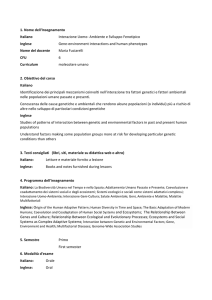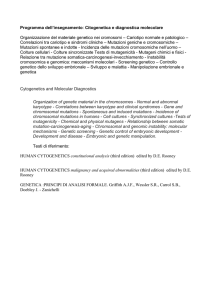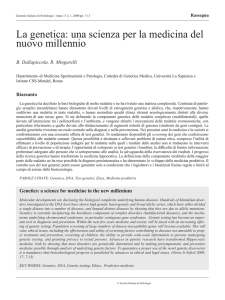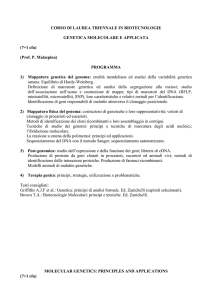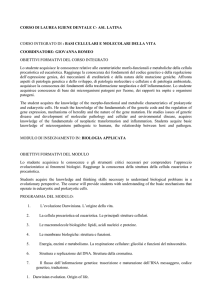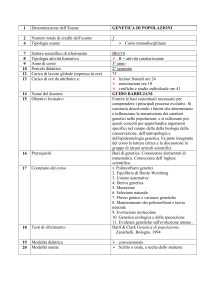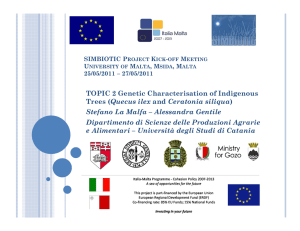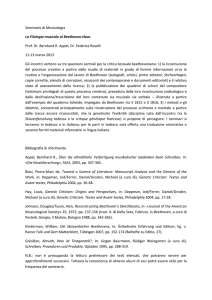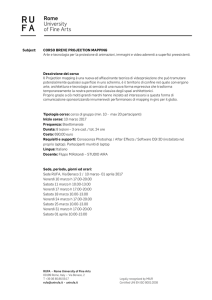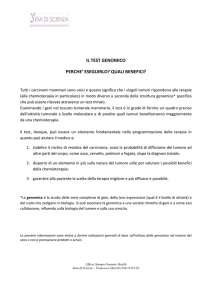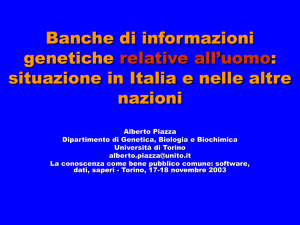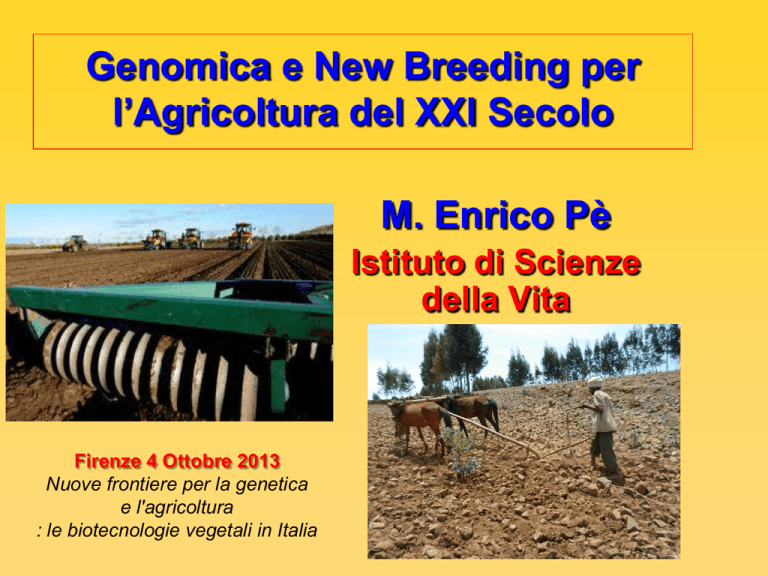
Genomica e New Breeding per
l’Agricoltura del XXI Secolo
M. Enrico Pè
Istituto di Scienze
della Vita
Firenze 4 Ottobre 2013
Nuove frontiere per la genetica
e l'agricoltura
: le biotecnologie vegetali in Italia
Le Grandi Sfide dell’Agricoltura
del XXI secolo
Aumento della popolazione
7 miliardi nel 2011
9 miliardi nel 2040 (ONU)
Cambiamenti climatici
già in atto
Agricoltura sostenibile
rispettosa dell’ambiente
ma produttiva
Alimentazione
e salute
qualità degli alimenti
Contributo del Miglioramento
Genetico: Fornire Varietà Nuove
1. Elevato potenziale produttivo
2. Elevate qualità nutritive e di trasformazione industriale
3. Stabilità produttiva
tolleranza/resistenza a stress
biotici e abiotici
4. Efficenza nell’utilizzo
delle risorse
metabolismo N, P, fotosintesi
traslocazione fotosintati, ecc.
COME?
Risorse genetiche
Miglioramento
Miglioramento Genetico è un processo
evolutivo accelerato diretto dall’uomo
Il miglioramento genetico è un processo ciclico lento e
costoso che si basa sulla riproduzione sessuale controllata e
sugli incroci tra individui scelti (selezione artificiale)
Bruegel il vecchio XVI sec.
Abbassamento della taglia uno dei pilastri della Green
Revolution degli anni ‘70
RELAZIONE GENOTIPO – FENOTIPO
PROBLEMA PRINCIPALE
GENOMA
GENI
TRANSCRIZIONE
AMBIENTE
RNA
mRNA
TRADUZIONE
PROTEINE
METABOLISMO
FISIOLOGIA
B73
Produzione e
vigore ibrido
FENOTIPO
F1
Sviluppo e risposta
a stress
H99
1 cm
ALCUNE IMPORTANTI DEFINIZIONI
Gene:
Alleli:
1. unità ereditaria
2. unità funzionale di DNA
Forme ALTERNATIVE dello stesso gene
…C C A T T G A C…
…G G T A A C T G…
Allele 1
…C C G T T G A C…
…G G C A A C T G…
Allele 2
PROBLEMA:
Determinare il significato funzionale
della variabilità genetica
• identificazione
• misurazione della variabilità
• analisi genetica
SIGNIFICATO MODERNO di GENOMA
L’intero contenuto di MATERIALE GENETICO - DNA In una cellula, in un organismo, o in una specie
Rappresenta il POTENZIALE
in termini di functionalità di un
organismo
Complessità di un
Genoma è descritta
come il numbero di paia
di basi (base-pairs o bp)
1 Mbp = 1 milione di bp
SEQUENCING A GENOME
Grapevine 500 Mb
Shotgun sequencing
(genomes equivalents)
Assembly
Gene Prediction
Annotation
LA GENOMICA VEGETALE in ITALIA
GENOMI PUBBLICATI
• Vite 2007
• Melo 2010
• Tartufo
• Patata 2011
• Pomodoro 2012
• Pesco 2013
• Abete rosso 2013
IN PROGRESS
• Frumento
• Olivo
• Citrus
Università
ENEA
CNR
CRA
RISULTATI PRINCIPALI
1. Una nuova generazione di
Giovani ricercatori con FORTI
COMPETENZE di Genomica,
Biologia Molecolare,
Bionformatica
2. Forte internazionalizzazione
LA SECONDA RIVOLUZIONE GENOMICA
Identification of Genetic variations NO LONGER
the Bottle Neck
Single Nucleotide Polymorphism - SNP - Identified by sequencing
- Their frequency depends on
several factors (1 in < 100 bp)
…C C A T T G A C…
Single Nucleotide …G G T A A C T G…
Polymorphism
…C C G T T G A C…
…G G C A A C T G…
Molecular Characterization
DNA-chips
Re-sequencing individual plants
GENETIC MAP
Molecular Marker
– Genetic locus that identifies a
position on the genetic map
1 centi-Morgan (cM) = 1 recombinant / 100 meiotic products
M1
G
20cM
M2
10cM
GENOTIPO RICOMBINANTE DI MAIS
Ogni punto una variante
Allelica
Blu = Genitore 1
Rosa= Genitore 2
Crop genetic diversity
Elite
Cultivars
Genetic
variability
Cultivated
Species
Natural
Populations
Genetic diversity
in wheat & friends
Exploitability
MAPPING PHENOTYPES: COMBINING
GENOMIC CHARACTERIZATION WITH
MEASUREMENTS
Bi-parental
population
Not
structured
population
MAPPING PHENOTYPES: COMBINING
GENOMIC CHARACTERIZATION WITH
MEASUREMENTS
Statistical
analyses
Zooming
on the
genome
Association Mapping is to EXPLICITLY test each
locus for association to a given trait
is M1 related to phenotype? YES/NO/(MAYBE)
is M2 related to phenotype? YES/NO/(MAYBE)
…
Each time, a regression
Y = μ + Xβ + ε
…and a test against H0 :
Y=μ+ε
Preliminary Mapping: Plant Hight
General Linear Model; phenotypic data averaged from two field replicas
Plant Height
GENOTIPO RICOMBINANTE DI MAIS
Ogni punto una variante
Allelica
Blu = Genitore 1
Rosa= Genitore 2
Regione che controlla la produzione
Increasing Mapping Resolution with
Multiparental Populations
A multiparental (8-ways) RIL is a highly
homozygous line whose genome is a
mosaic of eight parental genomes
realized
through
a
controlled
intermating scheme of eight founder
lines
followed
by
repeated
selfing/sibling generations.
Advantages
of 8-Ways RILs
Due to their multi-parental nature
• Higher probability of informative crossover
events
• Higher
average
number
of
small
recombination segments
• Higher mapping resolution
• Higher likeliness of a Trait/QTL to segregate
(broader base of variation)
The Collaborative Cross:
Mixing and Inbreeding
The Collaborative Cross design consists of two
main stages:
1. MIXING STAGE: progenitor lines are intercrossed
to produce a foundation population whose
genomes each contain some genetic material from
every founder line.
2. INBREEDING
STAGE:
randomly
chosen
individuals of the foundation population are inbred
(by selfing or sibling), each producing a distinct 8way recombinant inbred line.
1. Mixing Stage: Three Steps
Production of 2-way F1 from every distinct pair of
founders, generating hybrids of composition AB,
AC, . . . , FH, GH (diallel cross)
×
Inbred line
Group
Subgroup
A632
SS
B14A
►
A
AB AC AD AE AF AG AH
B73
SS
B73
►
B
BC BD BE BF BG BH
B96
TS
Suwan
►
C
CD CE CF CG CH
F7
Mixed
-
►
D
DE DF DG DH
H99
NSS
NSS-mixed
►
E
EF EG EH
HP301
Popcorn
-
►
F
FG FH
Mo17
NSS
CO109:Mo17
►
G
GH
W153R
NSS
NSS-mixed
►
H
S o urc e : Liu e t al. 2003
A
B
C
D
E
F
G
H
Disjoint Diallel 1:
Producing 4-Ways Hybrids
×
A
A
A
A
A
A
A
B
B
B
B
B
B
C
C
C
C
C
D
D
D
D
E
E
E
F
F
G
B
C
D
E
F
G
H
C
D
E
F
G
H
D
E
F
G
H
E
F
G
H
F
G
H
G
H
H
√
√
√
√
√
√
√
√
√
√
√
√
√
√
√
√
√
√
√
√
√
√
√
√
√
√
√
√
√
√
√
√
√
√
A B
√
A C
√
√
√
√
√
√
√
√
√
√
√
√
√
√
√
√
√
√
√
√
√
√
√
A D
√
A E
√
√
A
F
√
√
√
A G
√
√
√
√
A H
√
√
√
√
√
√
√
√
√
√
√
√
√
√
√
√
√
√
√
√
√
√
√
√
√
B C
√
B D
√
√
√
√
√
√
√
√
√
√
√
√
√
√
√
B E
√
B
F
√
√
B G
√
√
√
B H
√
√
√
√
√
√
√
√
√
√
√
√
√
√
√
√
√
C D
C E
√
√
√
√
√
√
√
√
√
√
√
√
√
√
√
√
√
√
√
√
√
√
√
√
√
√
√
√
√
√
√
√
√
√
√
√
√
√
√
√
√
√
√
√
√
Disjoint Diallel 2:
Producing 8-Ways Hybrids
ABCD pool
A
B
×
C
D
A
C
×
B
D
A
D
×
B
C
EFGH pool
×
ABCE pool
A
B
×
C
E
A
C
×
B
E
E
F
×
G
H
E
G
×
F
H
E
H
×
F
G
A
B
C D
E
F
G H
8-ways #1
DFGH pool
A
E
×
B
C
×
D
F
×
G
H
D
G
×
F
H
D
H
×
F
G
etc... 35 pools
A
B
C D
E
F
G H
8-ways #2
etc...
Phenotypic Variation:
An Example
Il Nuovo Collo di Bottiglia?
L’Analisi Fenotipica
To Double Yield by 2050 We Need AGE

